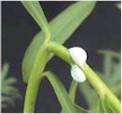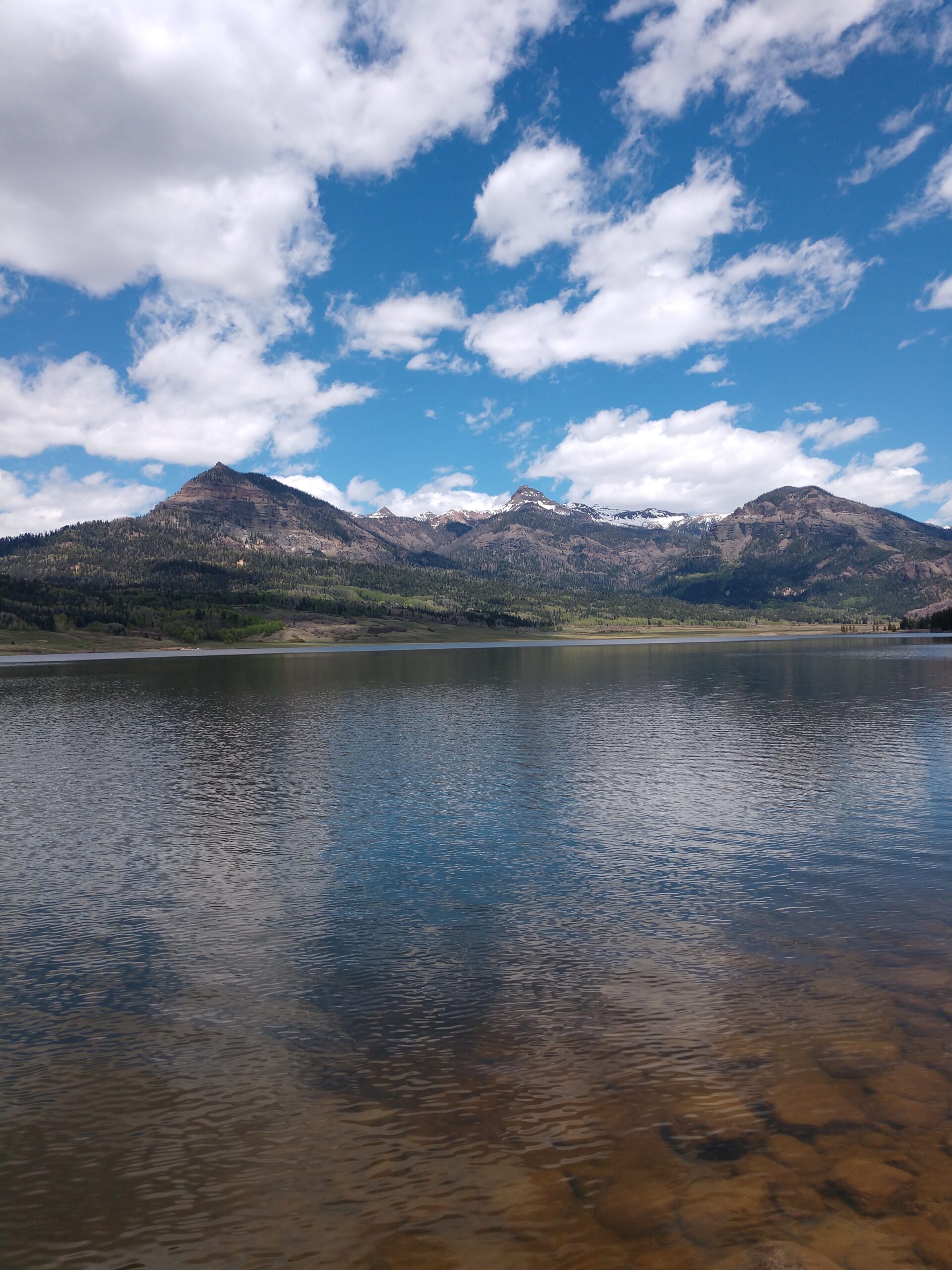Leafy spurge
Euphorbia esula L.
Keys to Identification
- Flowers are yellowish-green and have a pair of heart shaped yellow-green bracts below each inconspicious flower
- The entire plant contains white, milky latex
This information courtesy of the Colorado Natural Areas Program
Family
Spurge (Euphorbiaceae)
Other Names
None widely accepted.
USDA Code
EUES
Legal Status
Colorado Noxious Weed List B
Identification
Lifecycle
Perennial
Growth form
Forb
Flower
Flowers are yellowish-green, small, arranged in numerous small clusters and with by paired heart-shaped yellow-green bracts below. May-July.
Seeds/Fruit
Seeds are oblong, grayish to purple, contained in a 3-celled capsule.
Leaves
Leaves are alternate, narrow, 1-4 in long.
Stems
Mature plants are up to 3 ft tall. Stems are thickly clustered.
Roots
Extensive lateral root system.
Seedling
Seed leaves (cotyledons) are linear to lanceolate, with smooth margins.
Other
The entire plant contains white, milky latex. Foliage of the plant is smooth and hairless.
Impacts
Agricultural
Leafy spurge can invade rangeland that is in excellent condition, making it worthless for cattle and horse grazing and reducing land values (Lajeunesse et al. 1999).
Ecological
Leafy spurge is an aggressive, long-lived, perennial weed that tends to displace all other vegetation in rangeland, pasture, and native habitats (Biesboer 1998). Leafy spurge decreases rangeland diversity, threatens native plants and degrades wildlife habitat (Lajeunesse et al. 1999). It produces a large number of seeds and underground shoot buds. These two reproductive techniques allow it to rapidly displace native species, and form a leafy spurge monoculture. Rapid re-establishment of treated stands often occurs after an apparently successful management effort because of the large nutrient reserve stored in the roots of leafy spurge plants. Also, leafy spurge produces an allelopathic compound that inhibits the growth of other plants (Butterfield et al. 1996).
Human
The milky latex associated with leafy spurge can cause irritation, blotching, blisters, and swelling in sensitive individuals.
Habitat and Distribution
General requirements
Leafy spurge grows in a wide range of habitats. It is most aggressive in semi-arid areas, but can be found in arid to subhumid and subtropic to subarctic habitats (Butterfield et al. 1996). Leafy spurge occurs most commonly on untilled, non-crop areas such as rangeland, pastureland, woodland, prairies, roadsides, stream and ditches, and waste sites. It grows on all kinds of soils, but is most abundant in coarse-textured soils and least abundant on clayey soils (Butterfield et al. 1996).
Distribution
In Colorado, leafy spurge is common on disturbed or cultivated soils between 5,000 to 6,500 ft (Rutledge and McLendon 1998), but can be found up to 9,000 feet.
Biology/Ecology
Life cycle
Leafy spurge is one of the earliest plants to emerge in the spring, usually in mid-April to late May (Butterfield et al. 1996). The development of terminal flower clusters begins 1 to 2 weeks after stem emergence. Flower clusters have 8 to 16 branches. Each branchlet forms a greenish yellow bract in May. Flowering generally ends in late June to mid-July, and growth is reduced, during the hotter portion of the summer. However, if conditions are favorable, leafy spurge may produce a few lateral flowers throughout the summer and in the fall. Thus, it is possible for the plant to produce seed until frost. Seeds mature about 30 days following pollination. Peak germination occurs from late-May to early June. If adequate moisture is present, germination can occur throughout the growing season.
Mode of reproduction
Despite being a successful seed producer, leafy spurge primarily reproduces vegetatively through its extensive lateral root system. Long roots have the capability to produce shoots and can reach nearly 15 feet laterally, and about 30 feet deep. As many as 300 buds have been counted on these long roots (Butterfield et al. 1996).
Seed production
Each flowering stem produces from 10-50 capsules with 200-250 seeds per flowering shoot (Best et al. 1980). A large plant may produce up to 130,000 seeds (Rutledge and McLendon 1998).
Seed bank
Seeds can remain viable in the soil for 5-8 years although 99% of the viable seeds will germinate in the first two years (Butterfield et al. 1996).
Dispersal
The three-sided capsules explode when ripe, sending the enclosed seeds up to 15 feet from the parent plant. Seeds are covered in a sticky gell that can easily attach to animals and humans. Seeds float on water, and can be transported and deposited by flood water.
Note of caution
The milky latex associated with leafy spurge can cause irritation, blotching, blisters, and swelling in sensitive individuals. The eyes should never be rubbed until after the hands are thoroughly washed. Gloves should be worn while coming into contact with this plant (suggested cultural controls or ways to prevent spread).
References
Best, K.F., G.G. Bowes, A.G. Thomas, and M.G. Maw. 1980. The biology of Canadian Weeds .39 Euphorbia esula L. Canadian Journal of Plant Science 60: 651-663.
Beck, G.H. 1996. Natural resource series, leafy spurge. Colorado State University Cooperative Extension. Internet 07/28/98. Available:
Biesboer D.D. 1998. Element stewardship abstract on Euphorbia esula. The Nature Conservancy. Internet 07/28/98. Available:
Butterfield, C., J. Stubbendieck, and J. Stumpf. 1996. Species abstracts of highly disruptive exotic plants. Jamestown, ND: Northern Prairie Wildlife Research Center Home Page www.npwrc.usgs.gov/resource/othrdata/exoticab/exoticab.htm (Version 16JUL97).
Lajuenesse, S., R.L. Sheley, R. Lym, D. Cooksey, C. Duncan, J. Lacy, N. Rees, and M. Ferrell. 1994. Leafy spurge: Biology, ecology and management. Extension Bulletin EB 34, Montana State University, Bozeman, MT.
Lajuenesse, S., R.L. Sheley, R. Lym, and C. Duncan. 1999. Leafy Spurge. In: R.L. Sheley and J.K. Petroff (eds.) Biology and management of noxious rangeland weeds. Oregon State University Press, Corvallis. pg. 249-260.
Lym, R.G., K.E. Messersmith, and R. Zollinger. 1993. Leafy spurge identification and control. North Dakota State University Extension Service Publication W-765.
Lym, R.G. 1998. the biology and management of leafy spurge (Euphorbia esula) on North Dakota rangeland. Weed Technology 12: 367-373.
Rees, N.E., P.C. Quimby Jr., G.L. Piper, E.M. Coombs, C.E. Turner, N.R. Spencer, and L.V. Knutson (editors). 1996. Biological control of weeds in the west. Western Society of Weed Science in cooperation with USDA Agricultural Research Service, Montana Department of Agriculture, and Montana State University.
Rutledge, Chris R. and Dr. Terry McLendon. No Year. An Assessment of Exotic Plant Species of Rocky Mountain National Park. Department of Rangeland Ecosystem Science, Colorado State University. 97pp. Northern Prairie Wildlife Research Center Home Page. www.npwrc.usgs.gov/resource/othrdata/explant.htm (Version 15DEC98).
Whitson, T.D.(ed.), L.C. Burrill, S.A. Dewey, D.W. Cudney, B.E. Nelson, R.D. Lee, R. Parker. 1996. Leafy spurge. Weeds of the West. Western Society of Weed Science, in cooperation with the Western United States Land Grant Universities Cooperative Extension Services, Newark CA. pg. 316.




